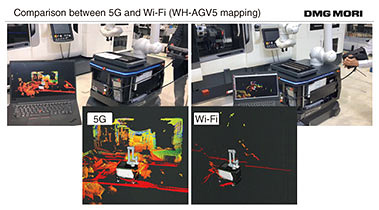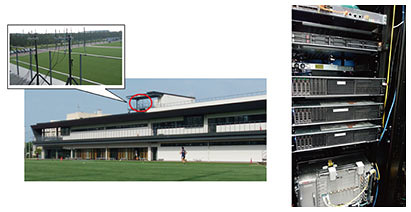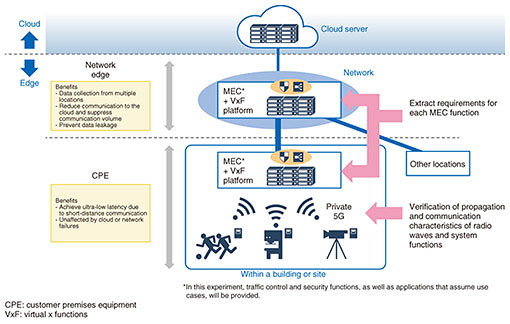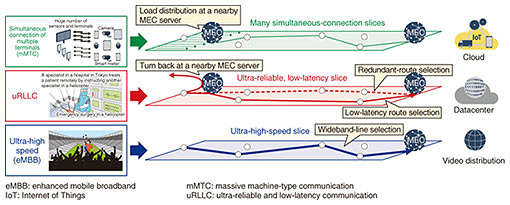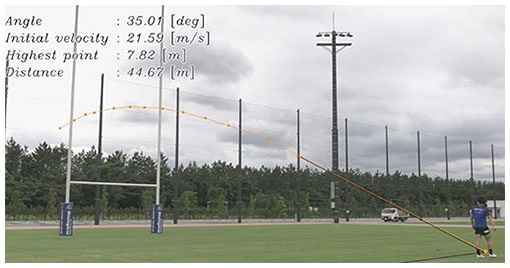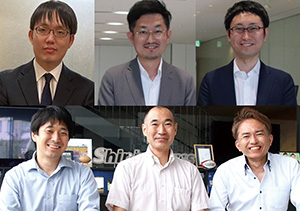 |
|||||
|
|
|||||
|
Feature Articles: ICT Solutions Offered by NTT Group Companies Vol. 19, No. 5, pp. 55–60, May 2021. https://doi.org/10.53829/ntr202105fa9 Private 5G: A Key Solution for Driving Digital Transformation and Creating a Smart WorldAbstractThe wireless technology called private fifth-generation mobile communication system (5G) is currently attracting attention from various customers, including the manufacturing industry. Unlike Wi-Fi, which has been widely used as a wireless-communication technology to build private networks, private 5G (called “local 5G” in Japan), which uses licensed bands, requires special expertise for design, construction, and operation. NTT Communications has accumulated knowledge of private 5G through conducting demonstration experiments even before private 5G was institutionalized in Japan. This article introduces examples of joint demonstration experiments with customers using private 5G networks as well as technologies under development such as multi-access edge computing and network slicing. Keywords: private 5G, digital transformation, network slicing 1. Data collection with private 5G, which supports digital transformation of customer businessAs a DX EnablerTM, NTT Communications (NTT Com) aims to join with customers in implementing digital transformation (DX), which will enable customers to create new businesses and strengthen their competitiveness. Data utilization is the key to implementing DX, and in 2019, NTT Com announced the Smart Data Platform for supporting it. The Smart Data Platform has all the functions needed to collect, store, manage, and analyze data. Private fifth-generation mobile communication system (5G)—a wireless communication technology to build private networks using 5G enabling advanced data collection—is also included on the Smart Data Platform as an essential technology for implementing DX. By using technologies, such as private 5G, to create an environment for secure data collection and storage and provide a one-stop solution for data integration, analytics, and utilization, NTT Com is aiming to help its customers create business value. 2. Achieve communication with mobile devices and flexible production systems in a secure and high-quality wireless environmentSome of the features of private 5G are high-speed/high-capacity, low-latency communication, and simultaneous connection with many terminals. In particular, the ability to communicate at high speeds with moving objects is eagerly awaited by customers. Collecting large amounts of data from moving objects, such as trains, cars, drones, and robots, in a stable and real-time manner has been difficult with conventional wireless communication technologies such as Wi-Fi. Private 5G will make it possible to quickly collect large amounts of data, such as video, thus expand the scope of data utilization. Security is another area in which private 5G is generating expectations. Similar to public 5G provided by mobile carriers, private 5G will use subscriber identity module (SIM)-based authentication and encryption to create a secure wireless communication environment. For example, the input and output data of various types of manufacturing equipment are highly confidential, and security must be ensured. By using SIM-based authentication and encryption in a private 5G environment, risks such as spoofing and eavesdropping can be significantly reduced, and data that are difficult to exchange using conventional wireless communication technology can be sent and received safely. The use of private 5G in situations in which robots work in collaboration with people is being considered. Applications of private 5G include collecting operational data of a robot in real time or assisting robot control from a remote location. NTT Com is conducting a demonstration experiment with DMG MORI CO., LTD. involving connection with robots via private 5G. Private 5G also has the potential to expand its applications to fields other than manufacturing industries. For example, it is expected to be applied to facility security using robots or to equipment inspection using drones. NTT Com formed a consortium with SOHGO SECURITY SERVICES CO., LTD. (ALSOK) and Keikyu Corporation to conduct a field demonstration under Japan’s Ministry of Internal Affairs and Communications’ FY2020 project “Development Demonstrations for Implementing Private 5G to Solve Local Issues” [1]. 2.1 Case study: Joint experiment with DMG MORIIn a joint experiment with DMG MORI, NTT Com is verifying the feasibility of using private 5G to remotely control an automatic guided vehicle (AGV) fitted with a collaborative robot. For example, by comparing the speed of collecting data about the state of the surrounding environment from the sensors installed on the AGV when using Wi-Fi or private 5G, we confirmed that private 5G can collect data faster and more stably than Wi-Fi (Fig. 1). By repeating such verifications, we are accumulating knowledge and expertise regarding the application of private 5G to machine tools. Through these demonstration experiments, we expect to further improve the performance of AGVs such as improving the accuracy and safety of transport and reducing the weight of AGVs by using edge computing.
3. Provide total coordination not only with private 5G but also with network-construction technology cultivated over many yearsNTT Com’s strength lies in its ability to not only build a private 5G environment but also provide optimal communication quality and solutions through total coordination of the entire system, consisting of from networks connecting to the edge and cloud to applications. NTT Com’s Smart Data Platform provides all the necessary functions for data utilization. Customers can collect and use data via private 5G by selecting and combining required functions such as network services (e.g., communication line, edge computing, and cloud computing) and various applications linked with private 5G. Another strength of NTT Com is that it can flexibly propose solutions. Regarding wireless communications, NTT Com is not only focused on private 5G; it may also recommend private LTE (Long Term Evolution), Wi-Fi, or LPWA (low power wide area) networks depending on the customer’s situation. NTT Com selects the most suitable equipment, services, and technologies for addressing customers’ issues and proposes them flexibly in a well-coordinated manner. 4. Demonstration experiment of private 5G at Arcs Urayasu ParkNTT Com’s efforts to develop private 5G technology is explained below. NTT Com obtained a license for private 5G experimental test using not only the 28-GHz band but also the 4.7-GHz band (which was institutionalized at the end of 2020) in June 2020 and started verifying radio wave-propagation characteristics at Arcs Urayasu Park, which is the training ground of NTT Com’s rugby team (Figs. 2 and 3). The radio-wave characteristics in the 4.7- and 28-GHz bands differ significantly, although both bands are used for private 5G. The 28-GHz band can be fit when communication speed is crucial; however, transmission or diffraction in relation to obstacles cannot be expected, and its reach is short. It will thus be more advantageous in situations in which 5G communications are used within the line of sight, which is close to the ideal wireless environment (namely, no obstructions exist between the base-station antenna and receiving terminal).
The 4.7-GHz band, however, can send radio waves farther than possible with the 28-GHz band and allows radio waves to be transmitted and diffracted (to some extent) even if obstacles are present. It is therefore possible to cover a larger area than that with the 28-GHz band, such as a factory site, with as few base stations as possible. In consideration of the characteristics of these two frequency bands, it is important to select the appropriate frequency band in accordance with the customer’s usage and communication needs. NTT Com is also investigating various aspects of the linkage between private 5G and other network services. In particular, it is focusing on a technology called multi-access edge computing (MEC), which processes data collected by private 5G communication on a network closer to the user side instead of on the cloud. For customers who require low latency, MEC can be deployed on-premises (i.e., for in-house information systems) to enable real-time data collection and utilization. Moreover, when NTT Com’s network services are used, it is possible to configure MEC at the network edge and use multiple levels of MEC depending on the application (Fig. 4). Furthermore, using NTT Com’s next-generation interconnect service Flexible InterConnect makes it possible to securely connect not only to the edge but also to various cloud services.
By using MEC in this manner, it is possible to (i) reduce the amount of data sent to the cloud while achieving low latency and (ii) increase the possibility of continuing processing even if there is a problem with the cloud or Internet due to a disaster or other event. This type of support is one of the strengths of NTT Com, enabling it to offer a wide range of services. 5. Verification of end-to-end network slicing with a stand-alone design methodA feature of 5G is network slicing, which is used to build a virtual network using software. The 5G specifications developed by 3GPP (the Third Generation Partnership Project) specify three types of slices: high-speed, high-capacity communication, low latency, and simultaneous connection of multiple terminals. Regarding private 5G, slices can be created in accordance with the requirements of each application or terminal (Fig. 5).
NTT Com aims to create a variety of detailed network slices—not only for private 5G communication but also for the networks behind it—and control these slices end-to-end. This makes it possible to configure networks that are tailored to each customer’s needs. For example, in highly confidential cases such as factory-operation data, the data can be placed on a slice on a closed network or on an on-premises network separated from slices connecting to information networks such as the Internet. In such a case, using Ericsson’s private 5G solution Edge Gateway* and each vendor’s products and technologies, NTT Com is conducting verification of sub-6 GHz bands and stand-alone design methods, end-to-end latency measurement and verification of slicing functions by connecting to backyard networks, and is expanding technological development and verification so that networks can be constructed flexibly. NTT Com will expand demonstrations by deploying private 5G in the actual field, such as installing various edge computing functions and linking with Smart Data Platform. NTT Com successively demonstrated real-time video analysis with private 5G in a verification environment set up at Arcs Urayasu Park. As shown in the photo in Fig. 6, a video of a player kicking a rugby ball is transmitted via a low-latency slice, and the angle and initial velocity of the ball are immediately calculated by an application on the MEC server. From the calculation results, artificial intelligence (AI) predicts the highest point and distance of the ball, then the trajectory of the ball is plotted on the original video and output.
Therefore, NTT Com will propose how to use private 5G as a total network solution in consideration of the envisioned use cases.
6. Concluding remarksAlthough private 5G is a new wireless communication technology, its foundation is none other than the network technologies that NTT Com have cultivated over the years. While using such technologies as well as the Smart City Lab (a co-creation environment) and considering services that can use private 5G at reasonable costs, it will accelerate co-creation with customers by creating private 5G services and solutions that promote DX for customers to create businesses and strengthen their competitiveness. Reference
Trademark notesAll brand, product, and company names that appear in this article are trademarks or registered trademarks of their respective owners.
|
|||||









